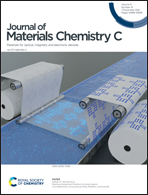Improving the power factor and figure of merit of p-type CuSbSe2via introducing Sb vacancies†
Abstract
As a thermoelectric material, p-type CuSbSe2 has attracted much attention due to its intrinsic low thermal conductivity and environment friendly constituents. In this work, Sb deficient compounds CuSb1−xSe2 (x = 0–0.12) are prepared by vacuum melting with spark plasma sintering (SPS) and their thermoelectric properties are studied. It is found that when CuSb1−xSe2 samples are deficient in Sb (i.e., x > 0), their electrical conductivity increases by more than two times (at 300 K) due to the increase in hole concentration caused by Sb vacancies,  . Moreover, experiments show that as the Sb vacancy concentration x increases to 0.09, the density of states effective mass is enhanced by ∼3 times, which leads to the 70% enhancement of thermopower (at 300 K). In addition, around 22% reduction of lattice thermal conductivity is observed due to the intensified phonon scattering by Sb vacancies, phonon–phonon scattering and phase boundaries. As a result, a peak power factor of 3.2 μW cm−1 K−2 and a maximum figure of merit ZT of 0.50 are achieved at 673 K for CuSb0.91Se2, which are ∼38% and ∼44% larger than those of pristine CuSbSe2.
. Moreover, experiments show that as the Sb vacancy concentration x increases to 0.09, the density of states effective mass is enhanced by ∼3 times, which leads to the 70% enhancement of thermopower (at 300 K). In addition, around 22% reduction of lattice thermal conductivity is observed due to the intensified phonon scattering by Sb vacancies, phonon–phonon scattering and phase boundaries. As a result, a peak power factor of 3.2 μW cm−1 K−2 and a maximum figure of merit ZT of 0.50 are achieved at 673 K for CuSb0.91Se2, which are ∼38% and ∼44% larger than those of pristine CuSbSe2.



 Please wait while we load your content...
Please wait while we load your content...